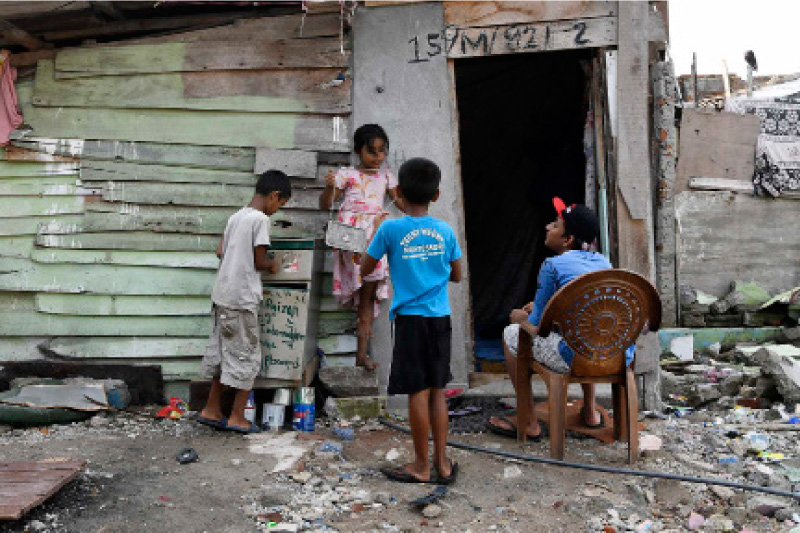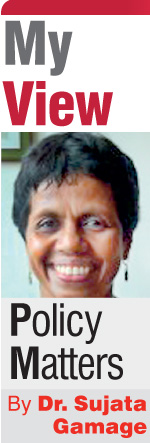Wednesday Apr 23, 2025
Wednesday Apr 23, 2025
Wednesday, 2 June 2021 00:00 - - {{hitsCtrl.values.hits}}

We may recover from the health impact or the economic impact, but the impact of lost years of education for children or children lost to the system due to dropping out will present a COVID education catastrophe with long-term implications – Pic by Shehan Gunasekara
 Schools have been closed for more than 16 months. News of school closures and brief re-openings have dominated the news. Success at holding examinations gives us a false sense of achievement. The Minister of Education has been heard to say that online education is continuing despite school closings. Such statements show a complete lack of understanding of the ground situation.
Schools have been closed for more than 16 months. News of school closures and brief re-openings have dominated the news. Success at holding examinations gives us a false sense of achievement. The Minister of Education has been heard to say that online education is continuing despite school closings. Such statements show a complete lack of understanding of the ground situation.
At the ground level, yes, teachers have been reaching out to students as best as they can. According to a survey carried out by the Education Forum Sri Lanka in November 2020, almost all teachers have used social media such as WhatsApp to reach out to their students, but they have been able to connect to only 45% of the students on average. Of those only ~5% were reached via software such as Zoom or Teams which give a real-time online education experience. Even for the 45% total who were contacted by schools, the mode of education is really a repeat of the usual chalk-talk education, but now in distance mode. The objective is to ‘cover’ the syllabus.
However, more important than covering the syllabus is having the school contact each child to inquire after his/her situation. We all know that it is difficult for children to be trapped inside. But in addition, not every home is a safe place for children. Domestic disputes affect the kids. These disputes can turn violent. In some homes, children are abused. Some disadvantaged children who receive school lunches could go hungry when schools are closed.
Warnings by experts
At a recent policy dialogue by the Education Forum Sri Lanka, Dr. Tara de Mel warned that we may recover from the health impact or the economic impact, but the impact of lost years of education for children or children lost to the system due to dropping out will present a COVID education catastrophe with long-term implications. She made a plea for short-term remedies to reach out to each child, and for planning NOW to reopen schools as soon as the present third COVID-19 wave subsides.
Weerasinghe, the Director of Education responsible for the Vavuniya South Education Division, echoed Dr. de Mel’s sentiments saying that the Vavuniya South division he represents has a diverse community from farmers in the interior to fishermen in the coastal areas, and children of such communities were difficult to contact. These children may have dropped out of education altogether.
Weerasinghe further said that during the lockdowns in 2020 rural schools gained somewhat on urban schools presumably because the small rural schools were able to work under the radar to bring children to school under health guidelines of local medical authorities. That is not possible now because the Ministry of Education has issued an all-encompassing closure of schools. Weerasinghe questioned the logic of applying equality of policies to a widely diverse set of schools.
For example, policies regarding school openings are made with crowded urban schools with students from across the country in mind, when smaller schools serving a contained community could well stay open. We need school-based solutions, he emphasised. Further he noted that we need to give pride of place to teachers and expect them to take responsibility for the education of children under their charge and supporting the teachers to do their job.
Renuka Peiris, former Director of Health and Nutrition at the Ministry of Education, noted that children are now expected to learn in a home environment which is quite different from the school environment. To compensate, they need to be given a timetable appropriate for self-study in a home setting and teachers need access to model lessons.
The teacher-student interactions should be tracked randomly to make sure that teachers are adapting well to the new mode. The focus in distance education is only on educational achievement and the three national examinations. Is that the objective of education, she asked?
There was consensus that there must be equal emphasis on student educational achievements, their social-emotional learning, and their health and well-being. In distance education the focus has entirely been on transmitting educational content, missing all three purposes of education.
Decentralising education management
Regarding decentralising education management allowing schools to make decisions about opening or closing of schools, Renuka Herath said that by statute the Director General of Health is the ultimate authority for all decisions related to a pandemic, but that power is delegated to Medical Officers of Health (MoH) at divisional level. At the school level, the principal may make the decisions in consultation with the MoH for the area, if power to make such a decision is delegated to the school level by the Ministry of Education.
There is indeed a circular from the Ministry that authorises schools to just that (Circular 2020/15) but when the ministry decides that all schools, say in the Western Province, should be closed, school-based committees cannot override such a directive. The Ministry of Education should make decisions on school opening or closing with sensitivity to children attending smaller schools serving small communities.
Time to act
Taking the ground reality into consideration, the Education Forum Sri Lanka has called upon the Ministry of Education and Provincial Departments of Education to recognise and act on the following without delay:
1. Content delivered over TV, WhatsApp or in print form is not education: The archaic transmission mode of education practiced in the Sri Lankan education system came to the fore during COVID-19. Teachers sent PDF files over WhatsApp to parents with smartphones, clogging their phones and forcing them to get pages and pages of notes printed. Learning happens not in transmission but in the engagement of the child with the content under the guidance of a teacher. Teachers need only send instructions to use existing textbooks and workbooks which should have been made available free to students at the beginning of the year.
2. Parents cannot replace teachers. Schools are responsible for keeping home-bound students engaged 7:30 a.m. to 1:30 p.m. on designated school days: A bi-weekly self-learning plan should be provided for each child and a teacher should follow-up with him/her at least once a day. Ninety six per cent of households in Sri Lanka have access to a mobile phone. Teleconferencing is possible with analogue phones. There is a teacher for every 16 students on average. There is no excuse for not reaching out to every child.
3. A reduced curriculum covering the essential learning outcomes in language and math, for example should be provided and teachers given the freedom to integrate learning outcomes in other subjects. The Academic Council of Bhutan, for example The Royal Education Council of Bhutan, for example, released an Education in Emergency (EiE) Prioritised and Adapted Curriculum as early as July 2020. National Institute of Education Sri Lanka has already identified ELC for primary education.
4. Diagnostic tests to identify the “learning lags” in essential competencies should be made for Grades 5 onwards for use by students for self-assessment or by teachers for keeping track. These can be developed and administered by Provincial, Zonal or Divisional directorate level.
5. Modalities for engaging in learning should be entrusted to schools, with supervision by closest authority and subject to schools covering essential competencies: On average only 50% of students engage ‘online’ learning. If the curriculum is reduced, teachers can use the time saved to reach out to those unreached using offline methods suitable for each locality.
6. School attendance committees at GND Level should be reactivated to monitor and support home-bound children: Children’s anxieties and mental health issues, abusive homes, poor nutrition are other critical issues. Regulation 1005/5 of 1997 mandated School Attendance Committees comprising principals, school development society representatives, and education health, and welfare authorities in each GND to keep track of families with school-age children. These committees should be reactivated immediately.
7. Decisions regarding school opening/closures should be delegated to authorities as close as possible to the affected communities: Schools in low-risk areas should be allowed to keep open. Even in high-risk areas, principals, and teachers in consultation with relevant committees can decide on appropriate school re-opening schedules and isolation modalities. Strategic plans for a more permanent way of keeping schools open should be developed with vaccinations and testing underpinning such plans.
8. Teachers are frontline workers. They should receive priority in vaccination: When health-care-workers are considered as frontline workers deserving immediate vaccination, the same should follow for teachers considering the repercussions of school closures across the society and the economy.
9. Personnel and students in schools in high-risk areas should be tested regularly: A cost-effective testing system should be designed so that teachers and students are tested regularly. If a student or a teacher is tested positive, individual classrooms or groups of students should be isolated, instead of closing the entire school.
10. Blended learning should be adopted as the norm when schools are in session so that teachers and students can transition smoothly to home-based learning during an emergency. Best-practices in this regard can be sourced from countries which have already adopted this kind of learning.
Discover Kapruka, the leading online shopping platform in Sri Lanka, where you can conveniently send Gifts and Flowers to your loved ones for any event including Valentine ’s Day. Explore a wide range of popular Shopping Categories on Kapruka, including Toys, Groceries, Electronics, Birthday Cakes, Fruits, Chocolates, Flower Bouquets, Clothing, Watches, Lingerie, Gift Sets and Jewellery. Also if you’re interested in selling with Kapruka, Partner Central by Kapruka is the best solution to start with. Moreover, through Kapruka Global Shop, you can also enjoy the convenience of purchasing products from renowned platforms like Amazon and eBay and have them delivered to Sri Lanka.
Discover Kapruka, the leading online shopping platform in Sri Lanka, where you can conveniently send Gifts and Flowers to your loved ones for any event including Valentine ’s Day. Explore a wide range of popular Shopping Categories on Kapruka, including Toys, Groceries, Electronics, Birthday Cakes, Fruits, Chocolates, Flower Bouquets, Clothing, Watches, Lingerie, Gift Sets and Jewellery. Also if you’re interested in selling with Kapruka, Partner Central by Kapruka is the best solution to start with. Moreover, through Kapruka Global Shop, you can also enjoy the convenience of purchasing products from renowned platforms like Amazon and eBay and have them delivered to Sri Lanka.